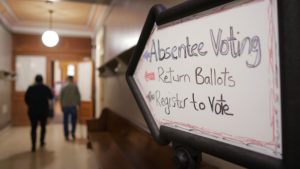Charlotte Observer
Local journalism.
December 6, 2018The Charlotte Observer’s reporting on election fraud is indicative of our need for local journalism, investigative reporting…specifically newspapers…and the role of the 4th Estate, a free press.
NC election scandal probe focuses on Charlotte-area political consultant
https://www.charlotteobserver.com/news/politics-government/election/article222690460.html
In response to “At center of voter fraud scandal, a convicted felon and ‘grassroots’ campaigner” :
It looks like the electoral fraud we’ve been searching for the past few years has been found in Bladen County. But as it turns out, it has nothing to do with non-citizens voting, someone hacking the voting machines or people impersonating other voters because NC doesn’t require ID.
Assuming the evidence holds up, the real problem is old-fashioned vote theft happening in razor-close elections and carried out by people getting paid out of a candidate’s campaign funds. It’s the real thing, and it has nothing to do with voter ID.
Photo: Gregory Rec/Portland Press Herald via Getty Images
The McClatchy Company is a publicly traded American publishing company based in Sacramento, California, and incorporated in Delaware.[2] It operates 29 daily newspapers in fourteen states and has an average weekday circulation of 1.6 million and Sunday circulation of 2.4 million. [wikipedia]
As ubiquitous as connectivity may seem for those who live in cities or suburbs with comfortable incomes, here’s the reality:
- Less than one-fifth of Americans live in a neighborhood where at least 80% of the residents have broadband, according to a report last year from the Brookings Institution.
- Nearly one-in-five teens are sometimes unable to complete homework because of lack of a reliable computer or internet connection, per Pew.
- Local news and information is becoming scarce and hard to access: More than 500 newspapers have closed or merged in rural communities since 2004.
The big picture: There are two types of “digital divide” operating today:
- The geographic divide: Rural and other areas are underserved because it doesn’t make financial sense for companies to invest in infrastructure.
- The economic divide: Infrastructure is in place, but lower-income families lack affordable access and devices.
Why it matters: These divides are colliding and combining in troubling ways — and creating a whole spectrum of education, information and privacy inequality.

The media haves and have nots.
- A record number of newspaper sales and closures/mergersvia the seven biggest newspaper investment owners have increased over the past five years.
- Only 17% of local news stories in a community are actually local, meaning they’re about or having taken place within a municipality, per a study from Duke earlier this year.
- While more people say they are willing to pay for news, those with higher levels of education are more likely to do so, per a study from the American Press Institute.
Between the lines: Benson says finding ways to create a plurality in types of news ownership will help to decrease the growing information gap in the U.S.
The bottom line: There’s a real news and information divide between rural and urban/suburban communities as well as between the poor and rich in the United States.
“Increasingly, journalism serves as a powerful force for exclusion, for keeping quality information away from those who need it most, for discouraging anyone but the richest, most educated citizens from participating in the public conversation.”— Rodney Benson, chair of NYU’s Department of Media Culture, and Communication
Digital Divide.
As ubiquitous as connectivity may seem for those who live in cities or suburbs with comfortable incomes, here’s the reality:
- Less than one-fifth of Americans live in a neighborhood where at least 80% of the residents have broadband, according to a report last year from the Brookings Institution.
- Nearly one-in-five teens are sometimes unable to complete homework because of lack of a reliable computer or internet connection, per Pew.
- Local news and information is becoming scarce and hard to access: More than 500 newspapers have closed or merged in rural communities since 2004.
The big picture: There are two types of “digital divide” operating today:
- The geographic divide: Rural and other areas are underserved because it doesn’t make financial sense for companies to invest in infrastructure.
- The economic divide: Infrastructure is in place, but lower-income families lack affordable access and devices.
Why it matters: These divides are colliding and combining in troubling ways — and creating a whole spectrum of education, information and privacy inequality.
Media pivots away from advertising
For decades the primary source of revenue for media companies was advertising. But competition from technology companies and more privacy scrutiny are pushing most media companies to explore alternative forms of revenue, Axios’ Sara Fischer reports.
- Why it matters: Most media companies have to unwind years worth of sales and product infrastructure to make way for the transition. Not all will survive.
Most companies are looking for creative ways monetize their owned and operated channels and content, but the transition away from advertising and Facebook traffic has been difficult.
- Subscriptions and memberships: Bloomberg, Vanity Fair, Wired, Business Insider, Quartz, New York Magazine, The Atlantic, The Daily Beast, HuffPost
- Commerce: BuzzFeed, CNN, New York Times, NBC
- Content licensing deals: Vox, New York Times, BuzzFeed, Axios, Refinery29, Conde Nast Entertainment
- Technology licensing deals: The Washington Post (Arc), New York Magazine (Clay), Vox Media (Chorus), Hearst (MediaOS)
Be smart: Most companies are in the experimental phase, and haven’t yet figured out what their long-term strategy for growth will be — if there is one.

